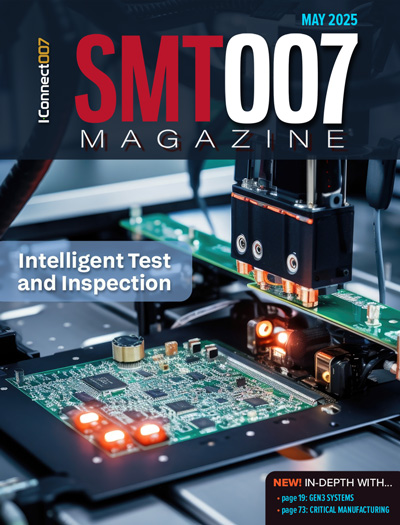-

- News
- Books
Featured Books
- smt007 Magazine
Latest Issues
Current Issue
What's Your Sweet Spot?
Are you in a niche that’s growing or shrinking? Is it time to reassess and refocus? We spotlight companies thriving by redefining or reinforcing their niche. What are their insights?

Moving Forward With Confidence
In this issue, we focus on sales and quoting, workforce training, new IPC leadership in the U.S. and Canada, the effects of tariffs, CFX standards, and much more—all designed to provide perspective as you move through the cloud bank of today's shifting economic market.

Intelligent Test and Inspection
Are you ready to explore the cutting-edge advancements shaping the electronics manufacturing industry? The May 2025 issue of SMT007 Magazine is packed with insights, innovations, and expert perspectives that you won’t want to miss.
- Articles
- Columns
- Links
- Media kit
||| MENU - smt007 Magazine
Design to Production Flow: DFT and Test Coverage Using Industry 4.0 Principles to Produce Good Products
December 1, 2021 | William Webb, ASTER TechnologiesEstimated reading time: 2 minutes
Achieving design for test (DFT) can be challenging for both design and test groups, as sometimes both expect that the other will be the one to manage DFT. The design and test groups might be in the same organization, or they could be an OEM vs. an EMS company. It works best if both the design and test groups are engaged in the process of DFT and trying to achieve the goal of the best test coverage and lowest rate of field returns.
Traditionally, design and test have operated in silos where there was not always the best communication, and at some point, the design was given to the test department to perform DFT. Often, due to project timelines and people working in different geographic regions, this means if some DFT concern was found, it may have been too late to address and resolve the issue. It is too late to wait until a board has gone through layout to begin DFT, as this needs to happen at the time of schematic capture, when the logic design is taking place, and before the board has gone for routing and layout. There are critical items that can be examined at the schematic capture phase to ensure that the board will be as testable as possible. A continuous feedback loop into DFT and test coverage understanding is key to producing defect free products at a minimum cost.
Companies must deliver good products to their customers, defect-free and at minimum cost. The challenge is how to detect or prevent defects from occurring so that only good products are shipped to the customer. Traditional DFT tools usually work only from the layout stage, which is too late in the whole process. Design data must be analyzed at the earliest stage possible in the product life cycle by importing schematic design data.
Electrical DFT rules violations should be identified and rectified prior to commitment to board layout, to prevent costly design re-spins. These rules can include standard and customer-specific checks relating to company requirements. With a centralized knowledge database, the same problems will never be repeated.
Test point requirements must also be identified pre-layout, during the schematic capture stage. This reduces the need for unnecessary test access, saving on PCB real estate, particularly on high density boards. The test strategy needs to be simulated, including any combination of inspection and test machines, delivering the highest test coverage. This unique combination provides electrical rules analysis, test point analysis, test strategy optimization, and test cost modeling based purely on schematic information. This, in turn, provides valuable layout guidelines that can be used to optimize the printed circuit board layout.
Once the PCBA layout is completed, a mechanical DFT analysis must be conducted to confirm the nets that require test access are not compromised by solder mask, component outline, adjacent probes constraints, etc.
To read this entire article, which appeared in the November 2021 issue of PCB007 Magazine, click here.
Testimonial
"In a year when every marketing dollar mattered, I chose to keep I-Connect007 in our 2025 plan. Their commitment to high-quality, insightful content aligns with Koh Young’s values and helps readers navigate a changing industry. "
Brent Fischthal - Koh YoungSuggested Items
Weller Tools Supports Future Talent with Exclusive Donation to SMTA Michigan Student Soldering Competition
07/23/2025 | Weller ToolsWeller Tools, the industry leader in hand soldering solutions, is proud to announce its support of the upcoming SMTA Michigan Expo & Tech Forum by donating a limited-edition 80th Anniversary Black Soldering Set to the event’s student soldering competition.
Koh Young Appoints Tom Hattori as President of Koh Young Japan
07/21/2025 | Koh YoungKoh Young Technology, the global leader in True 3D measurement-based inspection solutions, announced the appointment of Tom Hattori as President of Koh Young Japan (JKY).
Silicon Mountain Contract Services Enhances SMT Capabilities with New HELLER Reflow Oven
07/17/2025 | Silicon Mountain Contract ServicesSilicon Mountain Contract Services, a leading provider of custom electronics manufacturing solutions, is proud to announce a significant upgrade to its SMT production capability with the addition of a HELLER 2043 MK5 10‑zone reflow oven to its Nampa facility.
Knocking Down the Bone Pile: Addressing End-of-life Component Solderability Issues, Part 4
07/16/2025 | Nash Bell -- Column: Knocking Down the Bone PileIn 1983, the Department of Defense identified that over 40% of military electronic system failures in the field were electrical, with approximately 50% attributed to poor solder connections. Investigations revealed that plated finishes, typically nickel or tin, were porous and non-intermetallic.
SHENMAO Strengthens Semiconductor Capabilities with Acquisition of PMTC
07/10/2025 | SHENMAOSHENMAO America, Inc. has announced the acquisition of Profound Material Technology Co., Ltd. (PMTC), a premier Taiwan-based manufacturer of high-performance solder balls for semiconductor packaging.


